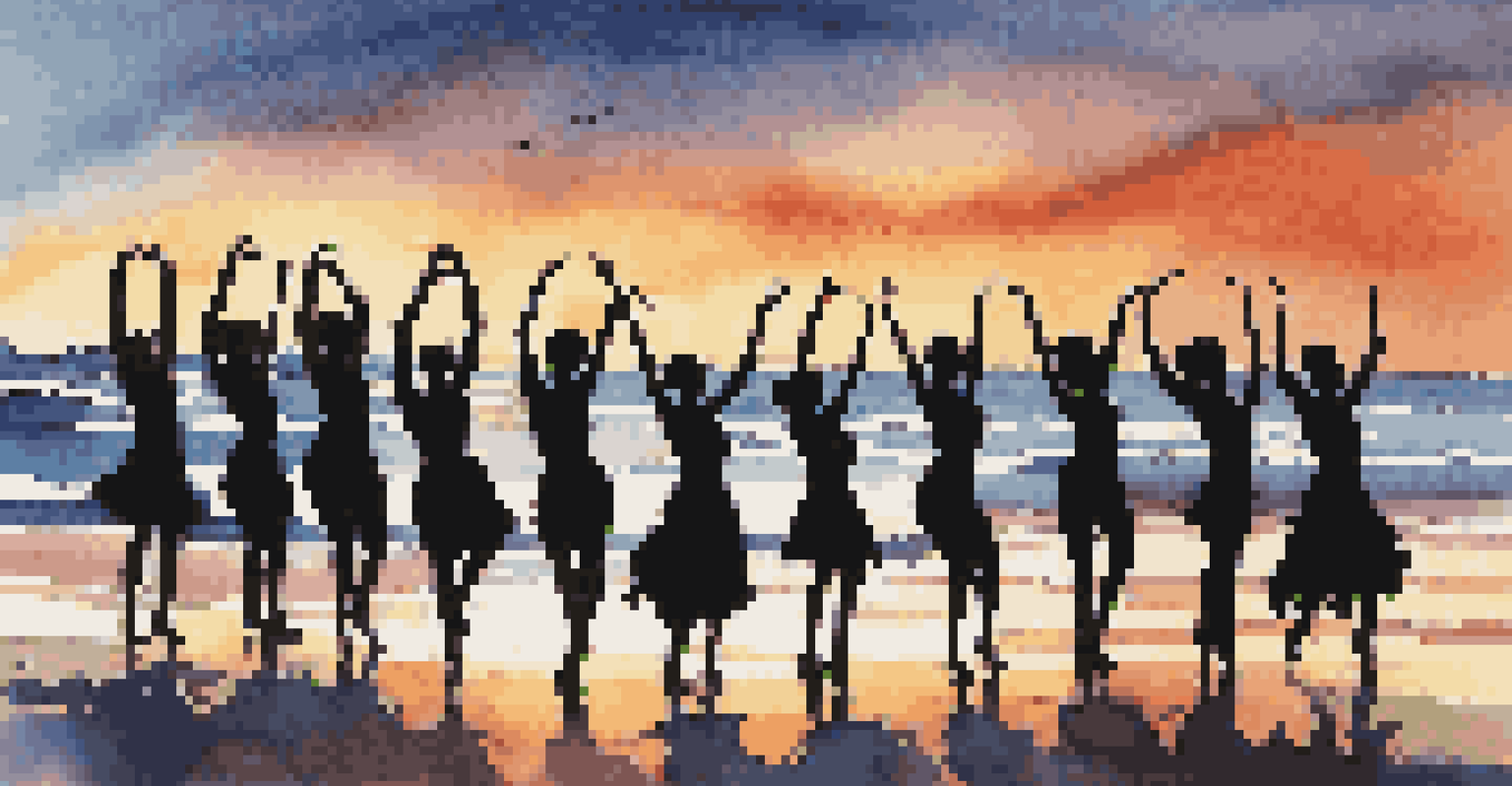Integrating Environmental Activism into Dance Performances

The Power of Dance in Advocacy and Activism
Dance has always been a powerful medium for expression, capable of conveying deep emotions and messages without words. When integrated with environmental activism, dance can transform a performance into a compelling call to action. Just like a powerful speech can move an audience, an evocative dance can ignite passion and awareness about pressing environmental issues.
Dance is the hidden language of the soul.
Consider how movements can mimic the beauty of nature, illustrating the delicate balance within ecosystems. For instance, a dancer might replicate the gentle sway of trees in the wind, drawing parallels to deforestation and climate change. This form of storytelling through movement not only captivates the audience but also plants seeds of thought about their own connection to the environment.
By harnessing the universal language of dance, artists can reach diverse audiences, transcending cultural and linguistic barriers. This accessibility makes dance a unique tool for spreading important environmental messages, inviting everyone to reflect on their role in preserving our planet.
Creating Compelling Narratives through Movement
Narrative is at the heart of any effective performance, and environmental activism in dance is no exception. Choreographers can weave stories that highlight the struggles faced by our planet, such as pollution, habitat loss, and climate change. By embodying these narratives, dancers can evoke empathy and inspire action in their audience.

For example, a dance piece could portray the journey of a river, showcasing its beauty and the threats it faces from industrial waste. This personification not only engages the viewers but also helps them to connect emotionally with the cause. The more relatable the story, the more likely it is to resonate with audiences, encouraging them to take a stand.
Dance as a Tool for Advocacy
Dance powerfully conveys environmental messages, transcending language barriers to inspire action.
Additionally, integrating multimedia elements, like video projections or soundscapes, can enhance these narratives. By combining visual and auditory components, performances can create a more immersive experience, drawing the audience deeper into the environmental issues being addressed.
Choreographing for Change: The Role of Dancers
Dancers themselves play a crucial role in the success of integrating activism into dance. They must not only master their physical craft but also embody the environmental messages they represent. This requires a deep understanding of the issues at hand, allowing them to perform with authenticity and conviction.
We do not inherit the earth from our ancestors; we borrow it from our children.
Training programs that emphasize environmental awareness can empower dancers to become advocates for change. Workshops and discussions on topics like sustainability and conservation can enrich their performances, making the activism aspect more impactful. Dancers who are passionate about environmental causes can inspire others through their performances, creating a ripple effect of awareness.
Moreover, when dancers take the initiative to engage with their local communities, they can help spread these messages beyond the stage. Community workshops, flash mobs, or public performances can encourage dialogue and inspire action, turning passive spectators into active participants in the fight for a healthier planet.
Collaboration with Environmental Organizations
Collaborating with environmental organizations can amplify the impact of dance performances. These partnerships can provide dancers with valuable resources, knowledge, and access to broader networks. By aligning with established environmental groups, dance companies can enhance their credibility and reach.
For example, a dance troupe might partner with a local conservation group to create a performance that raises awareness about a specific ecological issue, such as ocean plastic pollution. This collaboration not only enriches the dance with factual content but also opens up opportunities for joint campaigns and community events, further spreading the message.
Collaboration Amplifies Impact
Partnering with environmental organizations enhances the credibility and reach of dance performances.
Additionally, such collaborations can lead to fundraising efforts, where proceeds from performances go directly to environmental initiatives. This not only supports the cause but also shows audiences that their enjoyment of art can contribute to tangible change.
Utilizing Social Media for Greater Reach
In today's digital age, social media is a powerful tool for spreading messages far and wide. Dance companies can leverage platforms like Instagram, TikTok, and YouTube to showcase their performances and the environmental messages behind them. By sharing short clips or behind-the-scenes footage, they can engage audiences and spark conversations.
For instance, a viral dance challenge that highlights an environmental issue can encourage viewers to participate and share their own interpretations. This can create a chain reaction, amplifying the message and reaching audiences who might not have been exposed to these issues otherwise. The more creative and relatable the content, the more likely it is to capture attention.
Moreover, using social media to promote upcoming performances or campaigns can help build a community around environmental activism in dance. Engaging with followers through Q&As, discussions, or live streams can foster a deeper connection and motivate audiences to take action, reinforcing the idea that everyone has a role to play in protecting the planet.
Incorporating Sustainable Practices in Dance Productions
Just as important as the message is the method of delivery, and incorporating sustainable practices in dance productions can set a positive example. From using eco-friendly materials for costumes and sets to reducing waste during performances, every decision can reflect a commitment to the environment. This not only enhances the authenticity of the message but also encourages others in the industry to follow suit.
For example, a dance company might choose to use recycled materials for their costumes, showcasing creativity while minimizing environmental impact. This practice can inspire other artists and organizations to consider how they can implement sustainability in their own work. By leading by example, the dance community can create a culture of responsibility and care for the planet.
Sustainability in Dance Productions
Incorporating eco-friendly practices in dance not only delivers a strong message but also sets an example for the industry.
Additionally, implementing energy-efficient lighting and sound systems during performances can significantly reduce the carbon footprint of a production. Such initiatives highlight the commitment to environmentally friendly practices, reinforcing the message that caring for the earth starts at home.
The Future of Dance and Environmental Activism
The integration of environmental activism into dance performances represents an exciting evolution in the arts. As more artists recognize the importance of their role in addressing global issues, we can expect to see even more innovative and thought-provoking works that inspire action. The potential for dance to drive change is vast, and the future holds promising opportunities.
With the ongoing climate crisis, the urgency for activism has never been more critical. Dance, with its ability to evoke emotion and inspire dialogue, can play a central role in this movement. As artists continue to explore the intersection of creativity and activism, they will not only raise awareness but also encourage audiences to reflect on their individual and collective responsibilities.

Ultimately, the future of dance and environmental activism will rely on collaboration, creativity, and a shared commitment to making a difference. By uniting the arts with advocacy, we can create a powerful platform for change that resonates with people across the globe, ensuring that the dance community remains a vital voice in the fight for a sustainable future.